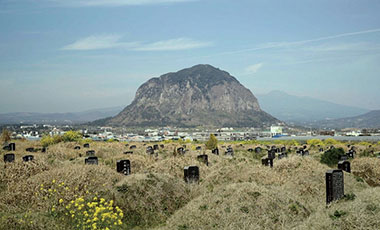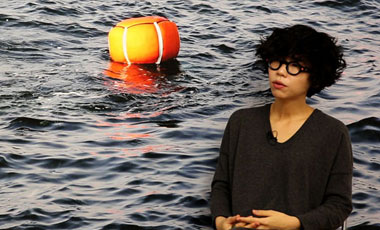Founded in Los Angeles in 2014 by Ellie Lee and Matt Connolly, the non-profit Equitable Vitrines responds to orthodoxy in contemporary art by producing site-specific projects in unconventional spaces. The idea for Equitable Vitrines began when Lee encountered two empty vitrines in the Equitable Life Building on Wilshire Boulevard, a Los Angeles mid-city skyscraper built in 1969 by the firm of prominent modernist architect Welton Becket.

Exhibition view: Yunhee Min, 〈Luminaire Delirium (Equitable Life or soft machine)〉, Equitable Vitrines, Equitable Life Building, Los Angeles (3 October–21 November 2015). Courtesy Equitable Vitrines.
Lee and her partner, artist Matt Connolly, negotiated with the buildings' management to transform the vitrines into public displays of contemporary art by creating a public platform for both an art and non-art world audience in the building's publicly accessible ground floor plinth. In the two years of exhibiting in the Equitable Life Building, from 2014 to 2016, artists including Battle Trance, Jennifer Moon, and Yunhee Min, and Klaus Weber presented work. Min's installation Luminaire Delirium (Equitable Life or soft machine) (2015) involved poured paint illuminated by fluorescent lights to create contrasts in form and colour, drawing on Southern California's light-saturated environment.
〈Will You Still Love Me: Learning to Love Yourself, It Is The Greatest Love Of All〉(2015) by Jennifer Moon consisted of a series of TV screens in one vitrine, transmitting live feeds of the artist's daily routine framed with famous quotes about love. The accompanying vitrine was emblazoned with text that read 'Learning to Love Yourself, It Is the Greatest Love of All', along with text, images, and photography referencing philosopher Jeremy Bentham's designs for the panopticon—a structure that allows a watchman to observe occupants without them being aware of whether or not they are being watched.

Equitable Life Building, Los Angeles (2014). Courtesy Equitable Vitrines.
Beginning in 2017, Equitable Vitrines has expanded its programme across different institutional sites in LA County. By adapting the unique approach they implemented within the lobby of the Equitable Life Building, they have developed an experimental protocol for the realisation of public art that is grounded in research and relationship-building around a chosen site. They first tested this new approach in the City of Monterey Park, California, where they worked for nearly two years to place a sculpture by New York-based artist Wang Xu in a beloved public fountain. While Equitable Vitrines ultimately rescinded its proposal in the midst of a confrontation at a meeting of Monterey Park's City Council, they went on to produce Garden of Seasons at the Vincent Price Art Museum (8 December 2018–9 March 2019). The exhibition consisted of a monumental figurative sculpture titled Athena (2018) and a two-channel video Garden of Seasons (2018), which poetically contrasts the process by which Wang made his sculpture and the various rhetorical acts committed and instigated by Equitable Vitrines in tandem. What results is a sensitive and provocatively ambivalent reflection on the relationship between physical objects and the various myths, both large and small, that are deployed in an attempt to render them animate.
Later this year, acclaimed artist Florian Hecker will present an installation of computer-generated sound interspersed throughout Rudolph Schindler's Fitzpatrick-Leland House in the Hollywood Hills, drawing from philosopher Jean-François Lyotard's concept of immaterials.
In this Ocula Conversation, Equitable Vitrines founders Lee and Connolly discuss site-specificity, expanded formats for exhibition-making, and the nuances of commissioning public art.
Equitable Vitrines began as a display of art in two vitrines of the Equitable Life Building in Koreatown, Los Angeles. How did this idea take hold?
Ellie Lee: My father, who is a lawyer, has had an office in the Equitable Life Building since I was little kid, so I've spent a good amount of time in the building, running through the halls while he had to work on some weekends, doing 'homework' and sunbathing on the roof while I was in high school. After graduating from USC with a degree in art, I almost immediately began working in his office as a design consultant on federal copyright cases, dealing primarily with textile designs used by his clients in the garment industry. I had always been peripherally aware of the vitrines—a rather conspicuous design element within the lobby—but it wasn't until I started working in the building that it struck me as strange that these two prominent display cases never had anything in them.
Matt Connolly: After doing some research, we determined that the vitrines were not part of the original plan for the building, which was designed by the well-known L.A. firm, Welton Becket Associates and completed in 1969. In fact, the lobby's current motif was established in the early 1990s, when the entire building was more or less gutted while undergoing asbestos abatement. We never determined who made the decision to install the vitrines, but we were able to track down a few tenants who had been around since the time of their installation, and by their account, the building's management had never shown any interest in using them to display anything. This points toward a theme that we have encountered repeatedly through our work, particularly in public or quasi-public spaces. Gestures toward art often satisfy the need for art, or the perceived need for art.

Exhibition view: Jennifer Moon, 〈Will You Still Love Me: Learning to Love Yourself, It Is The Greatest Love Of All〉, Equitable Vitrines, Equitable Life Building, Los Angeles (19 December 2014–20 February 2015). Courtesy Equitable Vitrines.
EL: In 2014, we approached the Equitable Life Building's management and requested access to the vitrines for the purpose of putting art in them. They were amenable, with some conditions, and we ended up producing six exhibits in the vitrines over two years. From the beginning, we felt that the negotiations we had with the building's representatives were no less important—no less a part of our overall project—than our conversations with the artists we worked with, and our built-in audience of tenants and visitors.
MC: Yes—bureaucrats, artists, and tenants—each required a different way of thinking and speaking about what art is and what it can or should do. It was important for us to realise that it is possible to talk about an idea or an artwork in quite different ways to different types of people, while being entirely sincere in each case.
EL: To add, by stepping outside of a more traditional exhibition scenario in which exhibitor, artist, and viewer share a number of assumptions about what is supposed to happen in a space where art is displayed, we found ourselves working through very foundational questions related to art as a mode of communication.



